Old product - Code30 / Code30-A
Code30-A
Professional DSP Data Analyzer and Decoder
Software for DOS, Windows 95 and Windows 98 - last release avilable v 2.8
CODE30-A are available now and will replace the DOS-only versions. The new decoders do work in a DOS box of WINDOWS® 95 and WINDOWS® 98 in multitasking environmrnt. WINDOWS® NT is NOT supported yet!
CODE30-A is the latest in a line of developments from HOKA in Digital Signal Processing (DSP) technology to hit the HF decoding scene. It is the world's first and only Software Data Analyser, Demodulator and Decoder with matched filters for IBM PC Compatibles.
CODE30-A doesn't use expensive hardware boards with sophisticated and dedicated microprocessor technology, but the unique combination of a simple Analog to Digital
(A-D) conversion with special optimized DSP software.
You might be thinking that if all those big companies are investing so much time and money into DSP hardware units, how can our method be any better than theirs?
Simple - it is very easy to design a DSP decoder in hardware, but it is so inflexible. Hardware implemented decoders are so difficult to program with continuously variable parameters that most DSP hardware manufacturers do not do this. They simply provide a set of fixed shifts and baud speeds.
Look at the long run of previous hardware-only solutions to decoding HF signals over the last few years - not exactly very easy or cheap to modify for any new keying systems that come along are they?
Hardware-only DSP decoders are going the same way again! Even now competitive products are still only offering the most common decoding systems! Code30-A offers more analysis tools and decoding modules than any other commercially available system.
History of CODE30 and CODE3
Hoka's CODE3 revolutionized the HF Radio Monitoring industry because it offered a high performance data analyzer and flexible decoder which was adaptive to future needs for little cost. The simple hardware interface (LF3) still amazes us at how well it performs! Keeping the hardware as simple as possible and allowing all the hard work to be done by the software has resulted in CODE3 managing to keep up with nearly all the latest RTTY signals heard on HF.
We have been able to offer a faster delivery time from initial interception of a new keying system than any other hardware decoder on the market today. We are still the market leader with highly sophisticated data analysis modules and over 50 different systems decodeable on the standard CODE30-A. That is many more features than commercial equipment 20 times in price! The analysis side of CODE300-A is unique. Some competitive hardware decoders allow one to output the data bit-stream, but with CODE300-A there are over half a dozen analysis tools available, each fully documented. Using just these tools alone, Hoka Electronics is able to analyze new keying systems and write new software modules to decode them.
Software CODE30-A
Software consists of three major parts, a sophisticated DSP Data Analyser, a high tech demodulator and a decoder able to decode over 50 completely different keying systems as follows but any other mode could be supplied in a very short time:
HF systems
- AUTOSPEC 10/20/50
- ARQ-6 70
- ARQ-6 90 - ARQ-6 98
- ARQ-E / ARQ 1000 D
- ARQ-N
- ARQ-E3 / CCIR 519
- ARQ-S / ARQ 1000 S
- ARQ CCIR 625 A
- ARQ-SWE
- ARQ-POL
- DUP-ARQ / ARTRAC
- RS-ARQ 240 MERLIN mode 5/7/8
- RS-ARQ 228 mode 5/7/8
- RAC-ARQ / MEROD
- HC-ARQ
- ASCII
- SITOR A/B CCIR 625 AUTO
- DIRTY SITOR A
- TWINPLEX
- MORSE / CW
- BAUDOT + Wx Synop Decoder AAXX BBXX
- BAUDOT F7B 2 CH
- FEC CCIR 625 B
- FEC-A / FEC 100
- FEC 100 INTERLEAVE
- FEC 100 RAW
- FEC-S / FEC 1000 S
- HNG-FEC
- ROU-FEC
- TORG 10/11
- PICCOLO MK VI 6 toni
- PICCOLO MK VI 12 toni
- COQUELET 8
- COQUELET FEC AUTO
- COQUELET AUTO ONLY
- COQUELET 13
- TDM CCIR 242 1,2,4 ch
- TDM CCIR 342 1,2,4 ch
- PACKET RADIO AX-25 Hf 300 Baud, VHF 1200 Baud
- PACTOR 1,2,3,4,5,6,7
- PSK 31
- G-TOR
- FACSIMILE AM / FM
- HELL
- NUM 13
- MIL 141-188 ALE
- HDFL HF-ACARS
- FIRE
- CROWD 36
- CIS 14 / AAMOR 96 BD
- 81-81
- ANNEX 10
- GMDSS HF / VHF
- DCF 77
- .... and many others on request.
VHF systems
- DTMF
- EEA
- EIA
- EURO
- CCIR 1
- CCIR 2
- CCITT
- NATEL
- VDEW
- ZVEI 1
- ZVEI 2
- DCSS
- CTCSS
- POCSAG 512 / 2400
- ERMES
- ATIS
- ACARS
- BOS-FMS
- FLEX
- MPT 1327
The most sophisticated 5-tone SELCALL
decoder / analyzer for all known systems is integrated. Making 'fingerprinting'
easy, the analyzer for these systems enables you to measure the tone
duration and frequency (offset) of any tone.
The detected five-tone-sequence is printed together with a time/date
stamp and can be saved on disk. All this measurements are made in real
time! To enable real 'on-air' monitoring, the S/N ratio of the signal
may decrease to up to - 5 db for detection of a tone sequence! The
calculated value of the S/N is shown in display.
Besides this a WATERFALL module enables one to put different rasters in
picture to see the good tone sequence.
An IF-spectrum display on 10 Kc center with up to 20 Kc frequency span,
zoom, waterfall etc. upgrades your receiver to a real HF-spectrum
monitor receiver.
CODE30-A integrates one of the best filter demodulators for extremely
signal conditions with a unique decoder and a sophisticated signal
analyzer, together with a DAT recorder with minimal 30 minutes storage
capacity into one system.
Any kind of 'production work' as well as any signal analysis can be done
with only one system: CODE30-A! Phase modulated signals as multitone
signals well, 5-tone decoder, testgenerator, sophisticated signal
analyzer with e.g. EYE PATTERN diagram? CODE30-A has it!
Nearly all system decoders are set, on initial entry, to the most
commonly found values of Baud speed, Shift, Character Repetition Cycle
etc. as appropriate for the keying system to make it easier for learners
to 'get up and running' as quickly as possible. Many modules are also
quite able to determine these settings for themselves by analysing the
signal whilst decoding it. E.g. the Sitor (Amtor) modules can
automatically adjust between ARQ Mode A and FEC Mode B without any user
intervention. About 40 different keying systems are included in our Auto
Classification module. After measuring the Baud speed, press [ENTER] to
jump via the Classify module into the monitored signal. What could be
easier?
Full user control over most parameters are possible. E.g. Unshift On
Space (by default CODE30-A reacts correctly to third shift keyboards to
stop the output becoming stuck in figures - but it is still useful to
switch this in on really noisy signals!), Shift On Space (great for
those noisy Meteo station signals!), Carriage Return Inhibit (saves
screen space and printer paper on press stations), force Letters or
Figure shift, select upper or lower case output, block length parameters
(e.g. 4 or 8), force re-synchronisation, ANY Baud speed between 5 and
800 Baud with easy quick selection of the most commonly found ones (i.e.25,
36, 45.5, 50, 72, 73, 75, 81, 82.5 7, 84, 96, 100, 100.1, 125, 144, 192,
200, 240, 300), along with fine manual adjustment in small increments.
Auto Threshold Control follows your receiver's drift. The decoder's
centre frequency can be adjusted to anywhere between 250 and 3500 Hertz
to allow for all types of receiver and demodulation methods (CW, SSB,
RTTY etc).
Another unique feature to CODE30-A is the ability to save all incoming
RAW digitised audio to disc (up to 30 minutes) for later analysis! A
complete DAT recorder/player in one decoding system. This record/play
facility can also be used for any kind of audio signal, from phase
modulated signals up to AM broadcast! View ALL channels of multi-channel
systems at once on screen (and their status e.g. RQ, Beta, Alpha, IRS,
ISS etc.), and not just those that are keying traffic. Save all four
channels, at the same time, to disc even!
FEC transmission systems transmit each traffic character at least twice
so as to allow the genuine recipient equipment to reconstitute any
corrupted characters. Unlike some other hardware decoders that simply
print the first character received, CODE30-A implements the system's
error correction protocol to maximise the received characters without
error. (In fact we go one better than that - if both characters are
received in error then CODE30-A will attempt to reconstruct the
character sent from the good elements of both corrupted characters!)
Why CODE30-A ?
Some of these facilities have been realized in the "old" CODE3 and CODE3
Gold Professional, why Code30-A ? We don't sit on our laurels!
A couple of years ago it was decided that DSP technology was the answer
to even higher performance. Digital Signal Processing and in particular
FIR filters permits a level of performance only bettered by the most
expensive mechanical filters. Mechanical filters can be made to perform
better than an 'equivalent' software FIR filter except they are
extremely inflexible. CODE30-A offers an infinite variety of bandwidths
that is just not possible by any other means.
CODE30-A does not use an 'off the shelf' DSP card quite simply because
DSP Cards require one to 'download' the software into their onboard
processor's memory. To adjust the centre frequency by 10 Hz or alter the
Baud Speed, or even the Shift settings would require one to download a
new set of software into the DSP card and start all over again. But in
the meantime you have lost the incoming signal whilst trying to set up
the card!
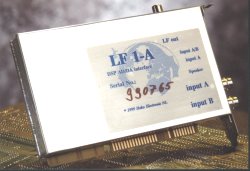
AD LF1-A Demodulator
DSP of CODE30-A
But how does the DSP part of the CODE30-A software work?
After the initial A to D conversion, the centre frequency of the system
being monitored (which maybe anywhere within the normal SSB or CW
passband of your receiver), is shifted down to DC. The signal will now
consist of two, in-phase and quadrature, components.
This complex signal is then passed through a software 'roofing filter'.
Because the filter is performed by the software rather than hardware,
the specifications are far better than any analog filter could ever be.
How about a transition from Passband to Stopband of less than 200 Hz!
The bandwidth of this filter is automatically calculated and optimized
dependant on the set shift and baud speed. Change the baud speed or the
shift by even small increments and the roofing filter will always
compensate automatically for the best bandwidth! The FIR filter is
configured using two possible sources of information. One can either
manually select the shift and baud speed settings or better still, use
the measured parameters of the signal. After this 'roofing filter', the
signal is then ready to be demodulated by one of many demodulation
methods, some of which are user selectable as follows.
Frequency discriminator demodulators must always have a low pass filter
to remove any high frequency keying components. Therefore a special and
optimized low pass filter is constructed in software which, just like
the roofing filter, is dependant on the set baud speed and shift.
Because the roofing filter and the post detection low pass filter are
both set up from parameters derived by measuring the signal being
received, this frequency discriminator will give a much better
performance than the frequency discriminators you may be used to working
with up to now. Another benefit of software filtering is that this
discriminator will accurately demodulate signals with a shift from 2000
Hz down to an amazing 10Hz with almost identical performance throughout
its range!
All frequency discriminators are intolerant of some degree of mistuning,
CODE30-A's FSK discriminator allows for mistuning of up to about one
third of the shift without any degradation of performance so is very
useful for when one is simply 'tuning around'.
The Frequency Exchange Keyed (FEK) Demodulator uses matched filters.
Using matched filters requires a little more care. With most hardware
units, the filter widths and shifts are preset, and any signal decoded
which does not match these pre-set values will not decode at the
hardware's maximum performance. With CODE30-A's matched filters they are
infinitely variable! After using the software tools within CODE30-A to
measure the monitored system's shift and baud speed, CODE30-A
automatically sets up optimized matched filters to those precise
measured values. No two systems have identical shifts and baud rates but
CODE30-A will always be able to ensure that it will be decoded using
matched filters that give you the maximum performance.
A simple 2 tone RTTY signal only requires two matched filters and so it
is easy to construct dedicated hardware to decode them very well. But
what about 4, 6, 8, 13 and 36 tone (or more) systems? No hardware
decoder can compete with CODE30-A in this respect because on a 486DX it
is easy to implement 13 matched filters for a 13 tone system! Can you
imagine the complexity of constructing a 13 tone demodulator? No wonder
CODE30-A is the only commercially available general purpose system able
to demodulate these more complex systems. Other demodulators include OOK
(On Off Keying) for Morse code, 2DPSK and 4DPSK.
A built-in audio amplifier from a D to A which means that one can
generate signals. Yes, generate a Piccolo Mk6, a Coquelet or ARQ-E or
TDM or ARQ6-90 etc. One is able to select from a growing number of
signals which are being written and added to this module all the time.
At the moment one can select from approximately 30 different systems AND
add in a precise amount of Gaussian 'white' Noise too! Select a certain
level of S/N and use the signal as a test signal source for testing
other decoders, or for training purposes even! Digitally record the
output and play it back through the CODE30-A input for testing the
performance of our software even!
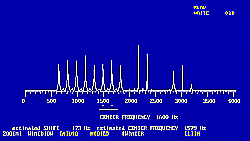 |
0 - 3800 Hz Audio Spectrum Analyzer showing VFT signal (J7B) | |
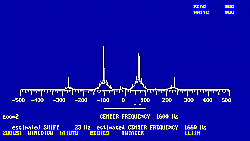 |
Zoom 2 - showing just one of the channels of the VFT signal. Note the total lack of adjacent signals due to the filtering !!! | |
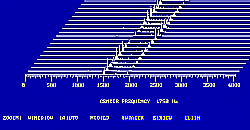 |
Waterfall in Skew mode 0 - 3800 Hz | |
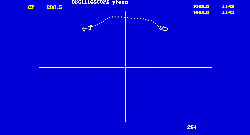 |
Phase display module showing PSK on 198 kHz Radio 4 |
Data Analyser
The Analysis of unknown or even known systems is a very important part
to serious radio monitoring on Short Wave. Whether to increase one's
personal knowledge about the numerous different keying signals or just
attempting to analyse something new and apparently undecodeable - a good
data analyser is an important tool.
Many decoders available today can offer baud speed measurement - so can
CODE30-A, but CODE30-A goes much further than that. CODE30-A is able to
measure system parameters never before available with hardware decoders.
Baud speed to a genuine accuracy of 0.0001 Baud (fingerprint), the
keying system's shift to the nearest 1 Hz, look and measure individual
element lengths, mark to space ratio, test for synchronous/asynchronous,
graphically display the element patterns. Auto-correlate the keyed
signal's bit pattern to search for tell tale signs of repetitiveness, or
not!
Display the analysed keyed signal with varying decoding alphabets (ITA2,
ITA3, ITA2-P, CCIR476, CCITT5) with character, bit or no interleaving,
various character lengths (from 5 to 9), various channel polarities -
all to try to identify the keying system's construction. The facilities
made available by using this Data analysis software will go a long way
towards reducing the number of times one says 'I wish I knew what this
system was'!
The following screen dumps show just some of the modules available:
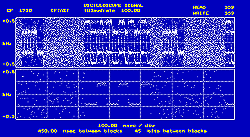 |
Oscilloscope showing four frequency Twinplex signal | |
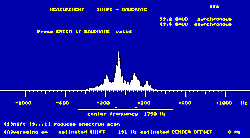 |
Shift Speed Measurement module showing four frequency Twinplex | |
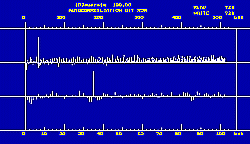 |
AutoCorrelation Bit module showing 100 Baud Sitor B with 35 element repetition. Top screen half shows bits from 0 to 512, Bottom half is the frist 100 bits 'zoomed' in. | |
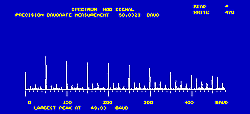 |
Autocorrelation MOD of unknown signal after FFT shows it to be a 50 Baud signal | |
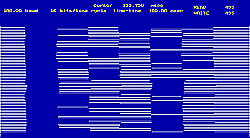 |
Speed Bit module shoiwing Asynch. 7 ˝ element of 50 Baud Baudot signal | |
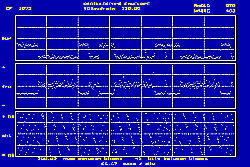 |
Amplitude, Frequency, Phase Oscilloscope | |
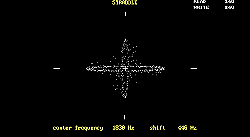 |
Straddle showing a tuned RTTY signal | |
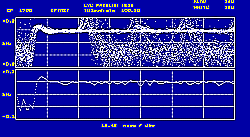 |
EYE Diagram show RTTY signal with RX bandwith too small | |
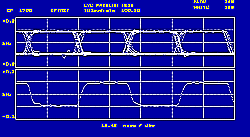 |
EYE Diagram show fairly good signal |
Technical specification
Computer requirements
- IBM 80486 Clone at 66 MHz or greater running MSDOS
- Pentium at 150 MHz or greater running Windows 95/98
General Features
- Fully integrated demodulator and decoder
- Mark and Space frequencies in 1Hz increments
- Baudrate control from 10 to 800 Baud, VHF systems up to 4800 Baud
- FIR roofing filter
- FIR matched filters for binary and multitone FEK
- Highly linear frequency discriminator with 'integrate and dump' low pass filter for FSK
- All selectable parameters may be set from the keyboard or imported from the various measurement modules
- Integrated test generator for most systems with selectable signal/noise ratio
- Phase Plane for frequency measurements of CW signals with 0.01 Hz resolution
The following alphabets are included in CODE30-A:
- International ITA 2
- National Scandinavian
- US MIL
- M2 CYRILLIC
- M2 LATIN
- M19 CYRILLIC
- M19 LATIN
- GREEK
- HEBREW
- ARABIC ATU 70 and ATU 80
- FARSI
- ARABIC ATU 70 and 80 LATIN
- Amateur Upper Lower Case
- USER DEFINED types are optional or on request available
- SYNOP DECODER (AAXX and BBXX)
included for BAUDOT, TORG and ARQE3, including a worldwide database.
Demodulator Specifications
- Demodulator Specifications
- Input impedance: 200 Kohm
- Nominal input level: +16 to -16 dBm (into 600 ohm selectable in 6dB steps)
- Maximum level: +30dBm without damage
- Dynamic range: Better than 40dB
- Input frequency range: 1 Hz to 3800 Hz
- Mark/Space centre frequency: Selectable from 200 to 3600 Hz in 1 Hz steps
- Shift: Selectable from 10 to 1800 Hz in 1 Hz steps
- Baud speed: Selectable up to 2400 Baud in 0.01 Hz steps
- Roofing filter bandwidth FIR filter: automatically adjusted according to selected/measured shift and baudrate
- Post-detection filter (FSK): automatically adjusted according to selected/measured baudrate
- Matched filter bandwidth (FEK): automatically adjusted according to selected/measured baudrate
- Bit error rate: Within 3dB of theory (white gaussian noise, non-fading channel)
- Modulation types detected: OOK, BFSK, MFSK, 2DPSK, 4DPSK and commercial 4, 6, 8, 13 and 36 tone FEK demodulators already implemented, also AM for SAT-FAX.
- Others on request.
Features of Audio Spectrum Analyzer
- 60 dB dynamic range, 512 point resolution frequency display
- 2 Zoomed display facilities. (1800 Hz and 900 Hz), display width of 0 Hz to 3800 Hz.
- Linear and Logarithmic vertical display representation
- Short time-window selectable, Video averaging and Maximum hold
- Waterfall display with vertical or 45 degree skew.
- Integrated frequency raster lines
for all SELCALL modes.
Download Code30-A data sheet